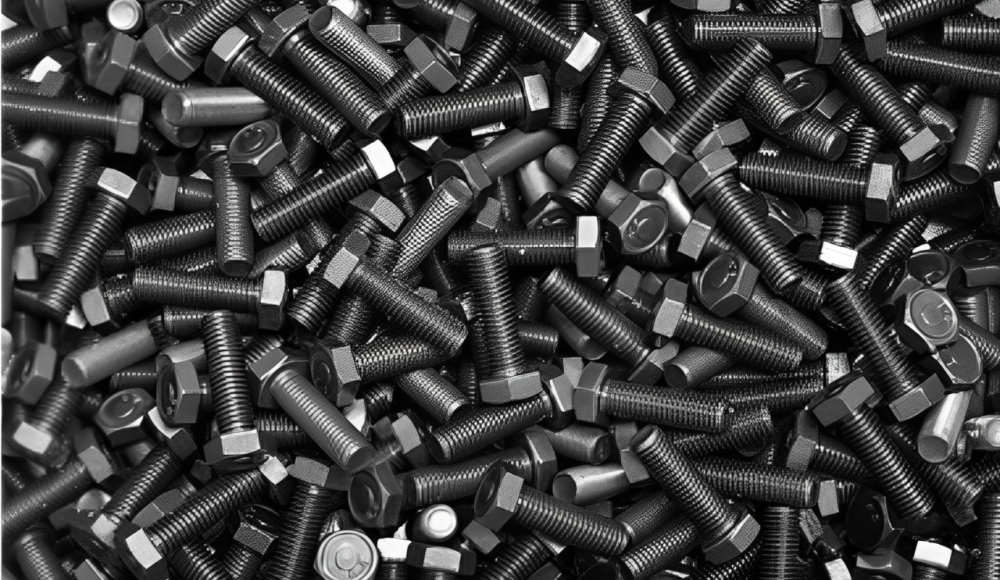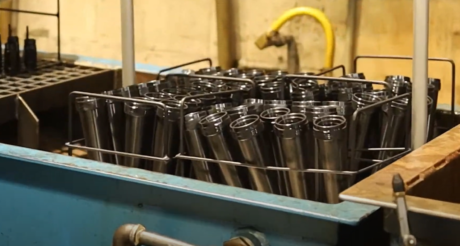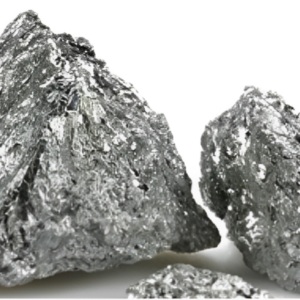Le revêtement d'oxyde noir est un traitement de surface bien appliqué qui améliore l'apparence, résistance à la rouille, et résistance des produits métalliques. Dans cet article, nous discuterons de tout sur le revêtement d'oxyde noir. Nous comprendrons son processus complet, avantages, inconvénients ainsi que les utilisations.
Qu'est-ce que le revêtement d'oxyde noir?
Le procédé de revêtement à l'oxyde noir est un revêtement chimique généralement appliqué sur les métaux ferreux., c'est à dire. acier et du fer. Il produit une surface noire et résistante à la corrosion et implique généralement une réaction chimique entre le métal et un agent oxydant.. Ces agents peuvent inclure une solution alcaline ainsi que de l'hydroxyde de sodium et des nitrates.. De plus, cette réaction donne un effet durable, finition noire esthétique qui améliore finalement les propriétés du métal.
Processus étape par étape de revêtement d’oxyde noir
Donc, voici les étapes du revêtement d'oxyde noir. Chacune de ces étapes garantit l’efficacité de ce processus.
1. Nettoyage
Le processus de revêtement noir à l'oxyde commence par le nettoyage des pièces métalliques pour éliminer la graisse, huile, saleté, ou des débris. Donc, ils ne gênent pas l'adhésion du revêtement. Cette étape nécessite généralement de nettoyer les pièces dans une solution alcaline propre.. Il aide à éroder et à éliminer les résidus présents sur la surface métallique. Une propreté extrême est importante lors de l'anodisation afin qu'aucun contaminant ne réside à la surface du métal. Comme ils peuvent empêcher la formation d’oxyde noir recouvrant la surface du métal.
2. Rinçage
Après le nettoyage, les pièces subissent une phase de rinçage. Ici, les pièces sont simplement lavées à l'eau. Donc, les traces du produit de nettoyage peuvent être éliminées avec d'éventuelles traces. Ce processus permet de rendre la surface exempte de tout produit chimique pour éviter toute réaction lors de processus ultérieurs.. Le rinçage s'effectue dans la plupart des cas dans des réservoirs conçus. Ici, nous pouvons utiliser l'agitation ou les ondes ultrasonores pour augmenter l'efficacité du processus de rinçage.
3. Oxydant
C'est l'étape la plus importante du revêtement d'oxyde noir. Ici, les pièces nettoyées et rincées sont immergées dans une solution alcaline chaude. Il contient principalement de l'hydroxyde de sodium, nitrates, et les nitrites, avec une température de 275°F à 300°F (135°C à 150°C). Cette solution à haute température réagit avec le fer présent dans le métal. Donc, il peut former une couche d'oxyde de fer noir (magnétite, Fe3O4). Le processus peut prendre du temps 10 à 30 minutes, en fonction de l'épaisseur et de l'uniformité souhaitées du revêtement. De plus, cette étape permet de créer la couche d'oxyde noir caractéristique. Donc, il peut donner aux pièces métalliques leur aspect unique et leurs propriétés améliorées.
4. Rinçage
Après oxydation, les pièces sont à nouveau rincées pour éliminer la solution oxydante ou toute trace de celle-ci. Cette étape de rinçage est très cruciale pour minimiser la corrosion. mis-à-part, il garantit que la qualité de la finition n'est pas altérée par les produits chimiques restants. Les pièces sont rincées dans des cuves identiques à celles utilisées lors des premiers rinçages.. Donc, ils peuvent garantir que tous les résidus de produits chimiques oxydants sont éliminés de manière adéquate.
5. Scellage
Ici, nous scellons les pièces pour ajouter plus de protection et augmenter la durabilité du revêtement d'oxyde noir. Dans cette étape particulière, les pièces sont pulvérisées avec un inhibiteur de rouille ou également avec un produit d'étanchéité à l'huile. Ensuite, il traversera les couches d'oxyde. De plus, ce traitement supplémentaire offre également une protection supplémentaire contre l'humidité et les produits corrosifs. Il augmente également la durée de conservation et l'efficacité du revêtement..
6. Séchage
Après scellement, toutes les pièces sont laissées sécher, ce qui est nécessaire pour une utilisation à l'étape suivante. Cette étape sèche les pièces pour éliminer l'humidité restante. Donc, ils sont complètement secs et prêts à l'emploi. Le séchage peut impliquer un séchage à l'air, séchage à la chaleur, c'est à dire. séchage au four, ou séchage centrifuge. Il ne doit y avoir aucune humidité sur la pièce qui pourrait nuire à l'efficacité du revêtement d'oxyde noir..
7. Inspection
Enfin, les pièces revêtues sont soigneusement inspectées pour répondre à des normes de qualité élevées. Il s'agit d'une sorte de contrôle visuel pour confirmer l'uniformité et la consistance des pièces dans le revêtement.. mis-à-part, cela peut également inclure des tests d'épaisseur de revêtement, adhésion, et résistance à la corrosion. De plus, les outils de contrôle, c'est à dire. jauges d'épaisseur, microscopes, et les chambres d'essai de corrosion sont souvent utilisées pour vérifier que le revêtement d'oxyde noir a été bien appliqué ou non.. Il vérifie également si le revêtement fonctionnera comme prévu dans son application prévue..
Matériaux utilisés avec le revêtement d'oxyde noir
Voici quelques matériaux que nous pouvons utiliser avec un revêtement d'oxyde noir.
| Matériel | Propriétés | Applications courantes |
| Acier | Abordable, fort, durable | Composants automobiles, pièces de machines |
| Acier inoxydable | Résistant à la corrosion, attrait esthétique | Instruments médicaux, ustensiles de cuisine |
| Fer | Castabilité, usinabilité | Objets décoratifs, outils |
| Alliages de cuivre | Résistance à la corrosion, durabilité, attrait esthétique | Matériel, objets décoratifs |
| Alliages de zinc | Prévention de la rouille, abordabilité | Attaches, petits composants |
Quelles sont les utilisations ou applications de l’oxyde noir?
Le revêtement d'oxyde noir est utilisé dans diverses industries comme:
- Pièces automobiles: Il contribue à améliorer l'esthétique et les caractéristiques anticorrosion des composants du moteur et des fixations..
- Composants aérospatiaux: Il offre une couche protectrice aux pièces de l'avion.
- Outils et matériel: Le revêtement en oxyde noir augmente la qualité des outils fabriqués à partir de métaux découpés et forgés..
- Instruments médicaux: Il est utilisé pour garantir que la surface des outils utilisés en chirurgie est propre et exempte de corrosion..
Puis-je faire une finition à l'oxyde noir à la maison?
Oui, il est possible d'appliquer une finition à l'oxyde noir à la maison. Cela peut être fait à l’aide de kits d’oxyde noir froid en manipulant correctement les produits chimiques et en suivant les procédures de sécurité.. Cependant, les services de revêtement professionnels sont de haute qualité et donnent des résultats cohérents, ils sont donc plus recommandés.
Quel est le Ddifférences Bentre Bmanque Ôxide et Ôlà Ssurface Fse termine?
Ce qui suit est un tableau concis pour expliquer la différence entre l'oxyde noir et les autres finitions de surface..
| Fonctionnalité | Oxyde noir | Revêtement en poudre | Anodisation | Chrome (Chromage) |
| Apparence | Noir, mat, ou finition légèrement brillante | Brillant, mat, ou texturé en différentes couleurs | Terne, éclat métallique, peut être clair ou teint | Brillant, réfléchissant, et finition brillante |
| Résistance à la corrosion | Bien, mais nécessite une étanchéité pour de meilleurs résultats | Meilleur, très haute résistance | Excellent, notamment contre la corrosion | Bien, très haute résistance |
| Durabilité | Modéré, peut s'user avec le temps | Très résistant, résistant à l'écaillage | Très résistant, peut être anodisé dur pour une dureté supplémentaire | Très résistant, résistant à l'usure |
| Coût | Généralement faible à modéré | Modéré à élevé selon la complexité | Modéré à élevé selon l'épaisseur | Haut, en raison de matériaux et de processus coûteux |
| Application | Pièces automobiles, outils, armes à feu, électronique | Pièces automobiles, appareils électroménagers, mobilier d'extérieur | Pièces aérospatiales, automobile, architectural | Pièces automobiles, objets décoratifs, outils |
| Épaisseur | Mince (microns) | Épais (mil) | Mince à modéré (microns) | Mince à modéré (microns) |
| Complexité du processus | Modéré | Haut, nécessite un traitement | Modéré, implique des processus électriques | Haut, implique plusieurs étapes, y compris le placage |
| Entretien | Nécessite un entretien et des retouches régulières | Faible entretien, résistant à la décoloration | Résistant à la décoloration | Faible entretien, résistant au ternissement |
Avantages du revêtement à l'oxyde noir
- Il aide à protéger contre la rouille et la corrosion, surtout avec l'étanchéité.
- Cela donne un aspect élégant, finition noire pour améliorer l'apparence.
- L'oxyde noir augmente la dureté de la surface et réduit la friction et l'usure.
- Il réduit l'éblouissement et est très utile pour les équipements de précision et les armes à feu..
- L'oxyde noir est peu coûteux par rapport aux autres finitions.
- Il ajoute une fine couche qui affecte peu les dimensions des pièces..
- Le revêtement d'oxyde noir retient les lubrifiants dans le revêtement poreux.
Inconvénients du revêtement d’oxyde noir
- C'est moins efficace tout seul, donc, il faudra peut-être le sceller.
- Le revêtement d'oxyde noir peut s'user et exposer le métal.
- C’est principalement pour les métaux ferreux mais ce n’est pas une bonne option pour les métaux non ferreux.
- Ce revêtement peut nécessiter un entretien et des retouches régulières.
- Sa finition finale peut varier en fonction des conditions de transformation.
- Cela nécessite généralement la manipulation de produits chimiques et de températures élevées.
Conclusion
En résumé, le revêtement d'oxyde noir est une solution assez rentable pour améliorer la résistance à la corrosion des pièces en métaux ferreux. Cela aide à fournir un look élégant, finition mate et augmente la résistance à l'usure et les propriétés lubrifiantes. De plus, il peut avoir besoin d'être scellé pour une protection optimale contre la corrosion. Le revêtement d'oxyde noir n'est pas une bonne option pour les matériaux non ferreux et les applications à forte usure. Cependant, il offre divers avantages dans le cas des métaux ferreux.
Questions fréquemment posées (FAQ)
T1. Quels métaux peuvent être recouverts d'oxyde noir?
Il est principalement utilisé sur les métaux ferreux tels que acier, fer, et acier inoxydable.
T2. Quelle est l'épaisseur du revêtement d'oxyde noir?
Les revêtements d'oxyde noir sont assez fins en moyenne 0. 00002 à 0. 0001 pouces (0. 5- 2. 5 microns).
T3. Le revêtement d'oxyde noir peut-il être utilisé sur les métaux non ferreux?
Non, l'oxyde noir n'est pas efficace sur les métaux non ferreux tels que aluminium, cuivre, laiton, etc..
T4. Le revêtement d'oxyde noir est-il respectueux de l'environnement?
Oui, le revêtement d'oxyde noir est inoffensif pour l'environnement extérieur. Il ne rejette aucun déchet dangereux.
Q5. Le revêtement d'oxyde noir peut-il résister à des températures élevées?
Le revêtement d'oxyde noir peut se dégrader à haute température. Donc, ses applications ne sont pas adaptées aux applications à haute température.
Contactez-nous pour plus d'informations.







3 réflexions sur "Un guide complet sur le revêtement à l'oxyde noir - Son processus, Applications et limites”